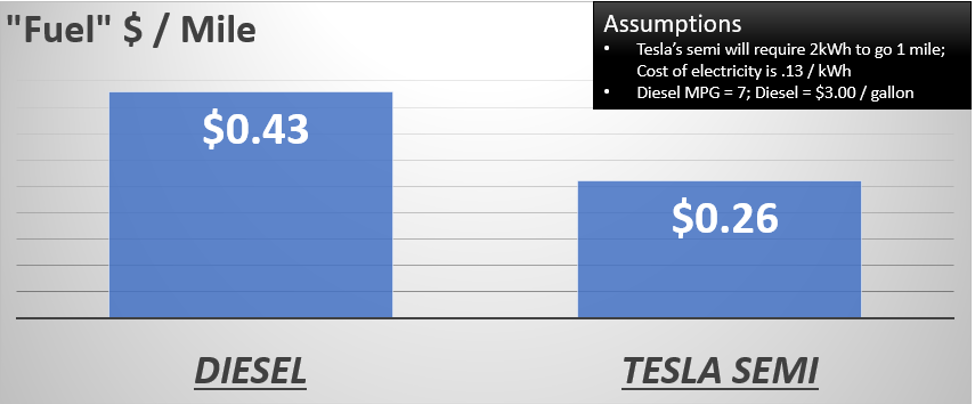Tesla has announced that their long-awaited, electric-powered “Semi” will be made available to some customers as early as the second half of this year.
The truck initially unveiled in prototype form back in November of 2017 has garnered a great deal of attention for its sleek look, 500-mile range and most importantly for truckers, its low operating cost. Elon Musk announced at the time that the cost/mile for the Tesla Semi would be .25 less than a traditional Class 8 diesel truck ($1.26 vs $1.51). For trucking companies with notoriously tight margins, this would be a game-changer, and a quick back of the envelope analysis comparing just the fuel savings component seems to confirm Musk’s statement.

When we also consider that electric motors are simpler, and therefore require less maintenance than internal combustion engines, perhaps Musk was even being modest in his predictions (a trait for which he is not particularly well known). When you add in the environmental and marketing benefits as well as Tesla’s investment in self-driving technology, the Tesla Semi would appear to be a no brainer for trucking executives. In fact, many companies reliant on efficient trucking operations have made reservations for the Semi including UPS, FDX, JB Hunt, Sysco, Anheuser-Busch and Ryder, to name but a few.
So, why would anyone buy a conventional diesel Class 8 Tractor anymore? Well, lots of reasons. Here are 7 challenges that Tesla, or any electric tractor manufacturer, will need to address in order to provide a truly competitive, long-haul option.
- National Charging Network – Unlike the approximately 10,000 truck stops where a diesel truck can fuel up while en-route, there is no national charging network for the Semi, and Tesla’s Supercharger network used by its automotive customers is not viable in terms of energy output. Therefore, these trucks will need to return to their domicile to be recharged. This will limit their use, at least in the short-term, to local routing and drayage environments.
- Cost of Charging Infrastructure – Initially, the Semi charging infrastructures will need to be built at Tesla customer locations. These “Megacharger” stations will need to provide truly astonishing amounts of power very quickly. Tesla has not been clear on what this technology looks like, the cost of the infrastructure and who will pay for it. To provide some perspective on the power needs, the average home in the US uses approximately 900 kWh in a month. Each Semi would require this amount in a 30-minute recharge. Put another way, each 30-minute charge will use the same amount of electricity as approximately 1500 houses.
- Hauling Capacity – Tesla has not disclosed the total weight of the tractor including the battery. However, based on the current state of battery technology, a 1.2 MWh battery would weigh in the neighborhood of 15,000 lbs. While electric motors are more efficient and lighter than their diesel counterparts, it is expected that the hauling capacity of the Semi long-range version will be 4000 to 8000 lbs less than a traditional tractor. If true, this would reduce haulable cargo weights from 45,000 lbs to perhaps 37,000-40,000 lbs.
- Lower Range – The 500-mile range of the Semi is impressive, but it is far short of the 1200-1400 mile range of a 200-gallon diesel tractor. A 30-minute charge only gets the battery back up to 80% of its total capacity, meaning the truck now has a maximum range of 400 miles, assuming optimal conditions. The chemical reactions of batteries become less efficient in non-optimal temperature ranges, so the range is further reduced in very cold or very warm weather.
- Upfront Cost – The long-range version of the Semi costs $180k ($200k for the “Founders” version). This compares to approximately $130k for a new, 2020 FreightLiner day cab tractor.
- Service – There is a large ecosystem of service providers and technicians in place to maintain and repair diesel engines and transmissions. No such infrastructure exists for the Tesla Semi. If repairs require the trucks to be serviced by Tesla repair technicians, this could increase both the cost of repair as well as the time the unit is out of service.
- Tesla’s Commitment to the Semi – Battery production has long been a constraint for Tesla. Therefore, one would question why Tesla would use 1.2 MWh in batteries for a $180k tractor when those same batteries could be used for 20 mid-range Model 3s that would generate $900k in revenue.
Musk said as much recently. “That’s part of the reason why we have not, for example, really accelerated production of the Semi,” [It] means making fewer Model 3 or Model Y cars.”
Summary
I don’t think anyone can argue with the “coolness” factor of the Tesla Semi. Its space-aged look is matched by its performance and technology. However, it is not a vehicle that can compete (yet) with the traditional diesel tractors in long-haul trucking for the reasons specified above. As battery technology advances and a national infrastructure of fast charging stations emerges, perhaps it will one day. But today, it is not a viable competitor in the long-haul segment.
About the Author
Mike Mulqueen is the Executive Principal of Strategy & Innovation at JBF Consulting. Mike is a leading expert in logistics solutions with over 30 years managing, designing and implementing freight transport technology. His functional expertise is in Multi-modal Transportation Management, Supply Chain Visibility, and Transportation Modeling. Mike earned his master’s degree in engineering and logistics from MIT and BS in business and marketing from University of Maryland.
About JBF Consulting
Since 2003, we’ve been helping shippers of all sizes and across many industries select, implement and squeeze as much value as possible out of their logistics systems. We speak your language — not consultant-speak – and we get to know you. Our leadership team has over 100 years of logistics and TMS implementation experience. Because we operate in a niche — we’re not all things to all people — our team members have a very specialized skill set: logistics operations experience + transportation technology + communication and problem-solving skills + a bunch of other cool stuff.


